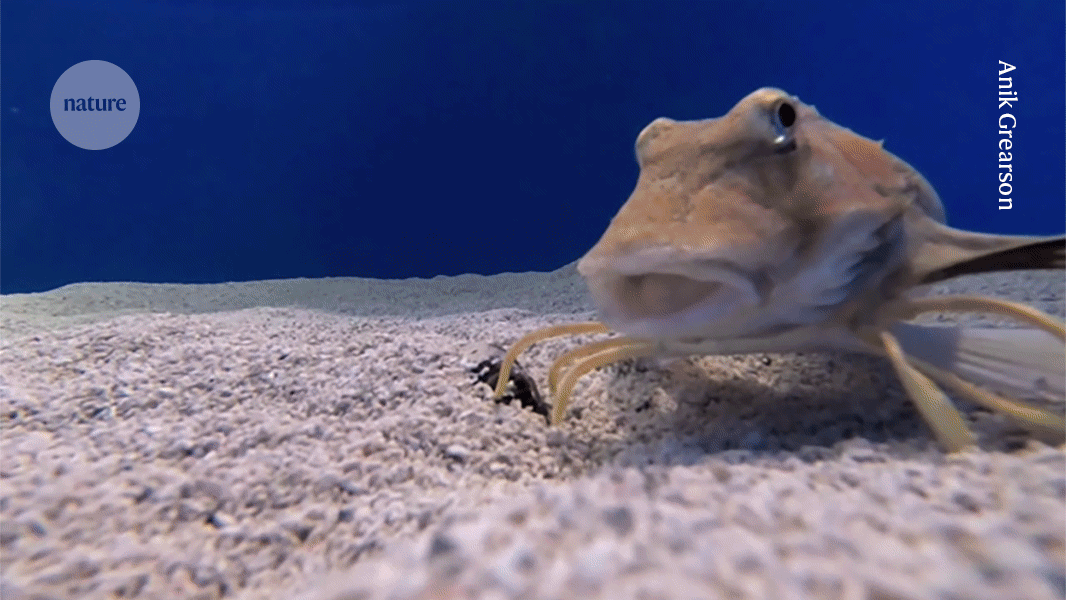This fish’s legs are made for walking — and tasting the sea floor

The northern sea robin has taste buds on its feet that can sense buried prey

A northern sea robin (Prionotus carolinus) scurries across the sand on its six legs, which it also uses as shovels and sensory organs.Credit: Anik Grearson
This fish has legs — but they’re not just for walking. Scientists have found that the northern sea robin (Prionotus carolinus) uses its limbs both to stroll the ocean bottom and to taste the sea floor for buried prey.
The research also uncovered clues about how P. carolinus repurposed its appendages as sensory organs over the course of its evolution. And genomic analysis revealed the evolutionary history of legs in the broader sea-robin family (Triglidae). The findings are described in two papers1,2 published today in Current Biology.
Fish with a difference
Sea robins have bulging eyes like a frog’s, fins that look similar to a bird’s wings and six legs resembling a crab’s. They are “the weirdest, coolest fish I’d ever seen”, says developmental biologist David Kingsley at Stanford University in California, who studies the animals.
Researchers have long known that P. carolinus’s legs have special sensory capabilities3,4. Molecular biologist Nicholas Bellono at Harvard University in Cambridge, Massachusetts, notes that the sea robins’ preternatural hunting abilities are so efficient that other fish follow them around hoping for leftovers. And it’s known that the fish’s six legs are covered with small bumps that look like taste buds. But scientists hadn’t probed the origins of the animal’s abilities in detail before.

The northern sea robin’s prowess at finding food attracts bands of hangers-on.Credit: Anik Grearson
Bellono’s team set out to change that and ultimately joined forces with Kingsley and his group. The researchers placed the fish in a tank with mussels and amino-acid capsules, all buried under sediment. The fish were able to find these items and dig them up with their shovel-like feet. A close look at these bumps, known as papillae, revealed taste-receptor molecules, which the researchers found were specialized in detecting amino acids and chemicals produced by deep-sea organisms.
But the most interesting finding came after the researchers had replenished their sea robin supply. These fish couldn’t find the buried food, and the researchers realized that they’d accidentally ended up with a different leggy species: P. evolans. This species’ legs were narrower and didn’t have papillae, suggesting that legginess and tasting ability had evolved separately.
The scientists compared the genomes of 13 sea robin species from around the world and drew an evolutionary family tree. This showed that legs for walking developed first. Sensory organs evolved on some species’ legs later.
Long-legs gene
After examining the genes active in the animals’ appendages, the researchers zeroed in on a gene called tbx3a. Experiments showed that it plays a part in creating a leg where other fish have a fin. When the researchers used the CRISPR–Cas9 gene-editing tool to mutate tbx3a in some P. carolinus, the fish lost their papillae and the ability to dig for food.
Tbx3a encodes a type of protein known as a transcription factor. A single transcription factor often regulates the activity of an array of genes, allowing it to have widespread effects. Bellono and Kingsley say that it’s clear that tbx3a plays some part in leg development and taste perception. But the scientists add that they don’t yet know which mutation caused tbx3a activity to change in species with sensory legs or how it created the fishes’ new abilities. Once they understand that, Kingsley says, researchers could theoretically use CRISPR genome editing to put legs and sensory organs on a different fish.
“They’re really nice, significant findings,” says Thomas Finger, a cell and developmental biologist at the University of Colorado School of Medicine in Aurora. He was surprised to see that some species lacked the ability to sense chemicals, but says that the study effectively showed how the ability seems to have evolved by tweaking an existing set of genes to form a new trait.
doi: https://doi.org/10.1038/d41586-024-03117-7
This story originally appeared on: Nature - Author:Sara Reardon


















